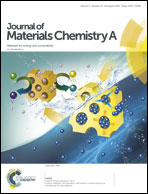Metal–organic framework-based nanofiber filters for effective indoor air quality control†
Abstract
Indoor air quality is essential to public health as people spend most of their time indoors. Hence, effective indoor air filtering is under heavy demand to deal with this challenge. Metal–organic frameworks (MOFs) have been demonstrated as suitable candidates for air pollution control because of their unique properties, such as large surface area and rich functionalities. The integration of MOFs into an organic polymer matrix is considered to be an effective method to control air pollution; however, an efficient and low-cost method to fabricate such filters is still lacking. Herein, an immersion method was proposed for embedding the homogenous growth of MOFs into nanofibers with a superior capability of wind resistance without film failure. The prepared MOF-filter shows effective PM2.5 and formaldehyde removal. The PM2.5 filtration efficiency increased from 74.5% to 87.2% after integrating ZIF-67 nanocrystals into the electrospun PAN nanofibers. Moreover, the PM2.5 filtration efficiency remains at more than 99% during a long-term test over 30 days. The ZIF-67@PAN filter also achieves a formaldehyde removal efficiency of 84%. This work not only proposes a scalable and low-cost method for fabricating flexible MOF-nanofiber filters but also holds great promise for improving indoor air quality and reducing the associated health risks.



 Please wait while we load your content...
Please wait while we load your content...